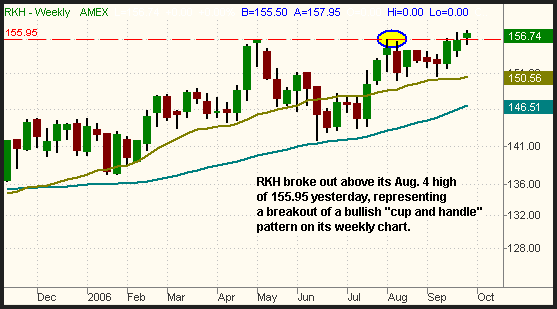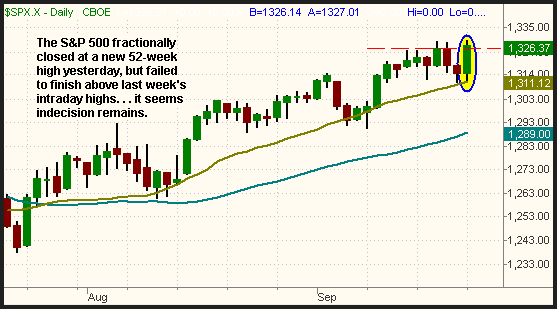Stocks immediately sold off after gapping up yesterday morning, but the buyers took control about an hour later, triggering a broad-based reversal. By mid-day, the major indices had rallied above their opening highs, then continued to trend higher throughout the afternoon. The Nasdaq Composite led the charge by advancing 1.4%, while the small-cap Russell 2000 followed closely behind with a 1.2% gain. The S&P Midcap 400 gained 1.0%, the S&P 500 0.9%, and the Dow Jones Industrial Average 0.6%. The S&P 500 marginally finished at a new multi-year closing high, but below last week's intraday highs.
Confirming yesterday's strength was a solid rise in turnover across the board. In the NYSE, total volume surged 22% higher, while volume in the Nasdaq was 12% above the previous day's level. The broad-based gains on higher volume gave bullish "accumulation days" to both the S&P and Nasdaq, a sign that institutions were behind the buying. Market internals were firmly positive as well. In the Nasdaq, advancing volume exceeded declining volume by nearly 5 to 1. The NYSE ratio was positive by just over 2 to 1.
Financials are one industry sector that has been showing good relative strength over the past several weeks. Within that sector, we found the Regional Bank HOLDR (RKH) to be among the best performing ETFs as well. Its 0.6% advance yesterday enabled RKH to finish not only at a new 52-week high, but at a fresh all-time high as well. The weekly chart of RKH is now showing a breakout of a bullish "cup and handle" chart pattern. Its rally above the August high of 155.95 corresponds to a breakout above the high of the "handle" and represents an entry point on the long side. We like RKH for long entry, just as long as the S&P holds up okay. Below is a weekly chart of RKH:

As mentioned in several newsletters over the past week, the main focal point on traders' minds continues to be the pivotal 52-week high in the S&P 500. On September 20, the S&P probed above its prior 52-week high on an intraday basis, but closed just below it. The index slid 0.8% in the successive two days that followed, pointing to a potential failed breakout at its high. But yesterday's rally pushed the S&P back up to test its high at the 1,326 to 1,328 area, indicating quite a bit of indecision over the past week:

Unfortunately, we are now looking at a situation in which neither the breakout to a new multi-year high nor the failed breakout we anticipated have confirmed themselves. In order to confirm an upside breakout, we need to see the S&P close above its high by more than a fraction of a point. The index also needs to convincingly rally above last week's intraday highs, as they represent a bit of overhead supply.
Conversely, the bearish "head and shoulders" chart pattern we illustrated in yesterday's Wagner Daily technically remains valid. While we admittedly did not expect the S&P 500 to rally all the way back to test last week's highs (the "head"), we can not say the "head and shoulders" pattern has failed until the index closes above the top of the head. Granted, this could easily happen today, but no need to jump the gun and cover any short position in the S&P 500 until you are proven wrong. When setting stops, we prefer to take the stress-free attitude of "set it and forget it." This means we simply stick to our predetermined stop price at all times, rather than spontaneously reacting to the market's day to day gyrations. This is especially important when price action becomes indecisive and choppy.
Our short position in the S&P Select Utilities SPDR (XLU) hit its trailing stop yesterday, but we locked in a decent gain in the process. Although we only netted a 2.1% gain on the trade, we were positioned with approximately double our average share size due to the low volatility of XLU. This enabled us to net an average capital gain on the trade. The number of shares we suggest to subscribers is always designed to provide both consistent risk and profit potential for each and every trade, regardless of whether an ETF trades with an average intraday range of 20 cents or 2 dollars. Failing to adjust your share size to account for the different volatility of each ETF is a sure way to take too much risk on the volatile positions and not enough risk on the slow movers. Open positions currently showing an unrealized gain are the StreetTRACKS Homebuilders (XHB) long and the Semiconductor HOLDR (SMH) short. The UltraShort S&P 500 ProShares (SDS) is in the red, but is still above our stop price.
Deron Wagner is the Founder and Head Trader of both Morpheus Capital LP, a U.S. hedge fund, and Morpheus Trading Group, a trader education firm launched in 2001 that provides daily technical analysis of the leading ETFs and stocks. For a free trial to the full version of The Wagner Daily or to learn about Wagner's other services, visit MorpheusTrading.com or send an e-mail to deron@morpheustrading.com.